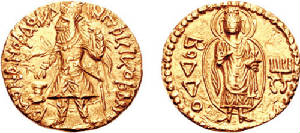|

C.8
ANCIENT. INDIA, Kushans. Kanishka I. Circa 127/8-152 AD. AV Dinar (7.93 gm, 12h). FAONANAOFAO KA-NHFKI KOFANO, Kanishka standing facing, head turned left, flames on shoulder, holding standard
in his left hand, sacrificing over altar to left / BODDO, Buddha, nimbate, standing facing, wearing
samghati (a long pleated garment), his head with eyes wide open and large moustache, ashnisha on head, urna
between eyebrows, his right hand is raised in the gesture of reassurance, abhayamudra, and he holds a pleat of his
robe in his left hand; tamgha to right. For a detailed study and complete listing of Kanishka’s Buddha coins in both
gold and copper, see Cribb, “Kanishka’s Buddha image coins revisited,” Silk Road Art and Archaeology
6. The three previously recorded Buddha gold dinars are as follows: MK 66 = BMC 16 (same obverse die); Tanabe, Silk Road
Coins The Hirayama Collection, 51 and cover coin (same reverse die); and Museum of Fine Arts Bulletin, Boston
1965, pg. 147, fig. 10 (same reverse die; stolen and destroyed, 1978). A fourth dinar, in a private collection, was recently
published by O. Bopearachichi in From Oxus to India (Lattes, 2002). Good VF, a few light marks. The fourth extant Buddha
dinar, the Boston specimen having been lost. ($200,000)
The name Kushan derives from the Chinese term Kouei-chouang,
used to describe one branch of the Yueh Chi, a loose confederation of Indo-European people who had been living in northwestern
China until they were driven west by the Turko-Mongol Hsiug-nu, in about 170 BC. The Yueh Chi reached Baktria in the second
century BC and by the first century AD were united under king Kujula. Gradually wresting control of the area from the Scytho-Parthians,
the Yueh Chi moved south into the northwest Indian region of Gandhara, today parts of Pakistan and Afghanistan. With its capital
established near Kabul, the Kushan Empire was soon acknowledged as great a power as China, Rome, and Parthia.
Under
Kanishka, the third king, the Kushan Empire reached its greatest extent, a territory ranging from central Asia into northern
India as far east as Benares and as far south as Sanchi. The empire was administered from two capitals: Peshawar near the
Khyber Pass, and Mathura in northern India. It was a period of great wealth marked by extensive mercantile activities, seagoing
trade and commerce along the Silk Route to China. This multi-ethnic empire, tolerant of religious differences, produced an
eclectic culture vividly expressive in the visual arts. Coin reverses as well as artifacts from the Gandhara and Mothura schools
of art exhibit deities of Greek, Roman, Iranian, and Hindu mythologies and some of the earliest representations of the Buddha.
Buddhism
is based on the teaching of Siddhartha Gautama, commonly known as The Buddha, who lived approximately 563 to 483 BC. The word
Buddha, meaning awakened or enlightened one, is a title, not a proper name. Siddhartha Gautama was born a prince in the kingdom
Sakyas situated on what is now the border area between India and Nepal. At the age of 29, desiring to know the path that leads
to the ending of all impermanence and anguish, and to ensure his permanent well-being, he renounced everything of the world,
becoming a homeless ascetic, vowing to find the path to ultimate enlightenment and resolving to teach others what he had discovered
about the Four Noble Truths and the chain of causation to achieve Nirvana.
Kanishka, a fervent Buddhist, is best remembered
today for sponsoring the first great Buddhist conference at Kanish Vihar, that led to the adoption and promotion of Mahayana
Buddhism, a school of thought that revered the life of Buddha as much as his spiritual teaching. The great bronze plaques
that recorded the conference proceedings have never been found, but we are fortunate to have a report of the conference from
the Chinese scholar Hien Tsang. The Buddha coinage was probably struck as a special issue in conjunction with the conference,
and the image of Buddha would have made a stunning impact at the time. Buddha had previously only been represented in symbolic
form, but under Kanishka the fusion of Greek and Indian culture led to the portrayal of Buddha in human form. Kanishka’s
coins were among these first representations and provide the earliest firmly datable images of the Buddha in any artistic
medium.
Significantly, our coin provides proof that the known Buddha dinars are from just one closely linked issue.
Two varieties of the Buddha dinar are known, with either a single halo (British Museum specimen) or a double halo (Hirayama
and Boston specimens). Our example, struck from the same obverse die as the British Museum piece and the same reverse die
as the Hirayama and Boston examples, now links all known specimens, proving they were struck in a single issue at just one
mint.

|

